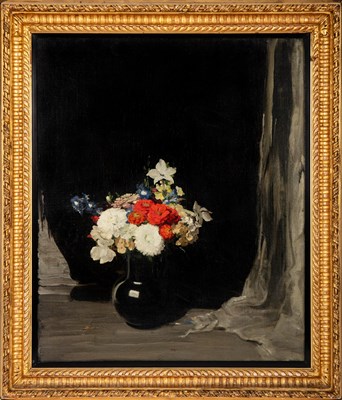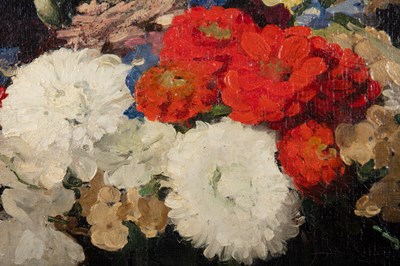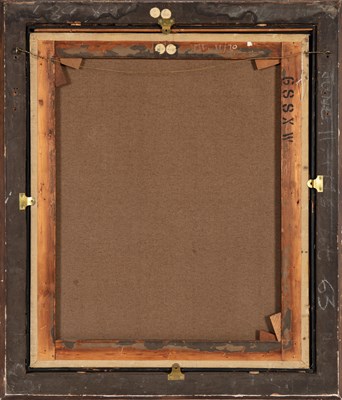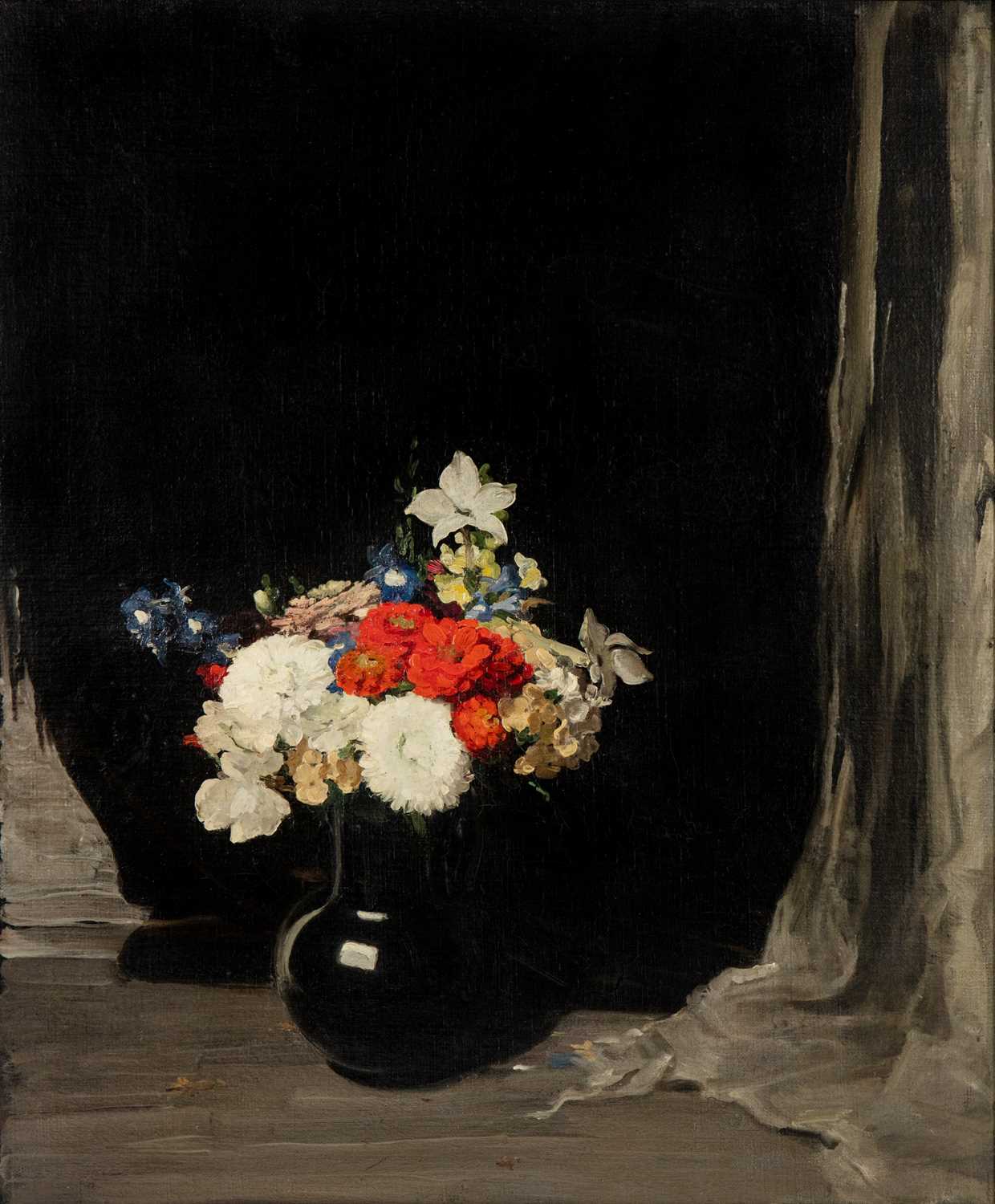13th Dec, 2023 12:00
Fine Paintings, Works on Paper & Sculpture
20
SIR WILLIAM NICHOLSON (BRITISH 1872-1949)
MIXED FLOWERS IN A BLACK JUG
oil on canvas
75 x 62cm; 29 1/2 x 24 1/2in
92 x 80cm; 36 1/2 x 31 1/2in (framed)
Property from a London Collection
Painted circa 1912.
Provenance
Sir James Murray of Glenburnie Park, Aberdeen (by 1920)
His sale, Christie’s London, 29 April 1927, lot 72 (as Flowers in a Black Vase)
Lord Blanesburgh of Alloa
Royal Caledonian Schools (bequeathed from the above in 1946)
Sale, Christie’s London, 18 July 1969, lot 28 (as Mixed Flowers in a Black Jug Standing beside a Curtain)
Mr Walker (purchased at the above sale)
Sale, Christie’s London, 11 July 1976, lot 69 (as Mixed Flowers in a Jug)
Mr O’Brien (purchased at the above sale)
Exhibited
Aberdeen, City Art Gallery, Sir James Murray’s Collection of Pictures, 1920 (as Flowerpiece)
Literature
‘Sir James Murray’s Pictures’ in Aberdeen Press and Journal, 21 May 1920
Patricia Reed William Nicholson Catalogue raisonné of the Oil Paintings, London, 2011, p. 237, no 271, illustrated in colour
William Nicholson’s flower pieces have always been popular, not least for the evident pleasure with which he approaches his subject. Often summer flowers that could be found in any garden are informally arranged in a variety of seemingly modest jugs and containers – creating a challenging combination of textures and colour. Here within the shallow picture space the flowers are dramatically presented against a dark chocolate velvet curtain, subtly distinguished from the glazed surface of the black Jackfield jug, with the flowers spot lit as on a stage. White nicotina stars with orange zinnias and blue delphiniums, while asters and others play a supporting role. Sometimes flowers depicted came from the artist’s garden in Rottingdean, but often when engaged on a portrait commission away from home Nicholson would chose flowers from his sitter’s gardens.
Black Jackfield pottery jugs date from the mid-18th century, their distinctive look made from mixing manganese with a dark firing clay at Jackfield, part of the Ironbridge-Coalbrookedale area in Shropshire. The Jackfield factory is now better known for the glazed and painted tiles found in Victorian and Edwardian homes and shops. Nicholson’s famous painting of 1916 The Hundred Jugs (Liverpool Art Gallery) features several used in his flower pieces but not, as far as can be seen, a black Jackfield jug.
The work is dated to circa 1912 on stylistic grounds; the composition is similar to Mauve Orchids in a Vase (Reed, ibid, p. 273) dated 1912. It is first recorded in the collection of Sir James Murray (1850-1933), when exhibited as part of the large art collection he had formed that hung in his London and Aberdeen homes. ‘…a beautiful composition of colouring’ declared the Aberdeen Press and Journal reviewing the 1920 exhibition. Having prospered in the Aberdeen meat trade Murray became Chairman of the Aberdeen Art Gallery Committee (1901-1928), and a major donor to the Gallery (founded 1885) both in terms of money and paintings. In 1917 he presented the Gallery with one of William Nicholson’s largest still lives The Brown Crow (1917) which, perhaps coincidentally, also includes a black Jackfield jug.
We are grateful to Patricia Reed for preparing this catalogue entry.
Sold for £160,000
MIXED FLOWERS IN A BLACK JUG
oil on canvas
75 x 62cm; 29 1/2 x 24 1/2in
92 x 80cm; 36 1/2 x 31 1/2in (framed)
Property from a London Collection
Painted circa 1912.
Provenance
Sir James Murray of Glenburnie Park, Aberdeen (by 1920)
His sale, Christie’s London, 29 April 1927, lot 72 (as Flowers in a Black Vase)
Lord Blanesburgh of Alloa
Royal Caledonian Schools (bequeathed from the above in 1946)
Sale, Christie’s London, 18 July 1969, lot 28 (as Mixed Flowers in a Black Jug Standing beside a Curtain)
Mr Walker (purchased at the above sale)
Sale, Christie’s London, 11 July 1976, lot 69 (as Mixed Flowers in a Jug)
Mr O’Brien (purchased at the above sale)
Exhibited
Aberdeen, City Art Gallery, Sir James Murray’s Collection of Pictures, 1920 (as Flowerpiece)
Literature
‘Sir James Murray’s Pictures’ in Aberdeen Press and Journal, 21 May 1920
Patricia Reed William Nicholson Catalogue raisonné of the Oil Paintings, London, 2011, p. 237, no 271, illustrated in colour
William Nicholson’s flower pieces have always been popular, not least for the evident pleasure with which he approaches his subject. Often summer flowers that could be found in any garden are informally arranged in a variety of seemingly modest jugs and containers – creating a challenging combination of textures and colour. Here within the shallow picture space the flowers are dramatically presented against a dark chocolate velvet curtain, subtly distinguished from the glazed surface of the black Jackfield jug, with the flowers spot lit as on a stage. White nicotina stars with orange zinnias and blue delphiniums, while asters and others play a supporting role. Sometimes flowers depicted came from the artist’s garden in Rottingdean, but often when engaged on a portrait commission away from home Nicholson would chose flowers from his sitter’s gardens.
Black Jackfield pottery jugs date from the mid-18th century, their distinctive look made from mixing manganese with a dark firing clay at Jackfield, part of the Ironbridge-Coalbrookedale area in Shropshire. The Jackfield factory is now better known for the glazed and painted tiles found in Victorian and Edwardian homes and shops. Nicholson’s famous painting of 1916 The Hundred Jugs (Liverpool Art Gallery) features several used in his flower pieces but not, as far as can be seen, a black Jackfield jug.
The work is dated to circa 1912 on stylistic grounds; the composition is similar to Mauve Orchids in a Vase (Reed, ibid, p. 273) dated 1912. It is first recorded in the collection of Sir James Murray (1850-1933), when exhibited as part of the large art collection he had formed that hung in his London and Aberdeen homes. ‘…a beautiful composition of colouring’ declared the Aberdeen Press and Journal reviewing the 1920 exhibition. Having prospered in the Aberdeen meat trade Murray became Chairman of the Aberdeen Art Gallery Committee (1901-1928), and a major donor to the Gallery (founded 1885) both in terms of money and paintings. In 1917 he presented the Gallery with one of William Nicholson’s largest still lives The Brown Crow (1917) which, perhaps coincidentally, also includes a black Jackfield jug.
We are grateful to Patricia Reed for preparing this catalogue entry.
Auction: Fine Paintings, Works on Paper & Sculpture, 13th Dec, 2023




